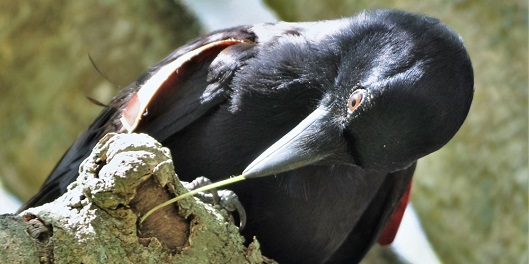Tool-bending birds prompt ‘clever crow’ rethink

Biologists at the University of St Andrews have observed tool-manufacture behaviour in wild New Caledonian crows, which may mean that textbooks on animal intelligence will have to be rewritten, according to a paper published today (Wednesday 10 August 2016) in Royal Society Open Science.
In 2002, ‘Betty’ the New Caledonian crow astonished the world, when she deftly bent a straight piece of garden wire into a neat hook to lift a small food-baited bucket from a vertical tube – a puzzle researchers had set for her in a laboratory at Oxford University. Although it was known at the time that these tropical corvids manufacture tools from twigs in the wild, it seemed highly unlikely that this involved any bending actions. Betty apparently understood the requirements of the experimental task and spontaneously came up with a ‘clever’ solution.
The paper that described these observations shook the field of comparative cognition, and is widely regarded as one of the most compelling demonstrations of ‘insightful’ or ‘intelligent’ behaviour in a non-human animal.
In an unexpected twist, however, recent field experiments by a team of St Andrews biologists have now revealed that tool bending is part of New Caledonian crows’ natural behavioural repertoire, casting doubt on Betty’s problem-solving prowess. Project leader Dr Christian Rutz explains: “We had provided wild-caught crows with juicy treats hidden in wooden logs, as well as with their preferred plant material for tool manufacture. We were absolutely over the moon when the birds started making and using tools in our field aviaries.”
But then something completely unexpected happened: some of the crows vigorously bent their twig tools during processing, in exactly the same manner as Betty had bent wire in the famous Oxford experiment – even though this time, bent tools were not required to solve the task. “We couldn’t believe our eyes,” Dr Rutz recounts. “Most birds trapped sticks underfoot before bending the tool shaft by bill, but one also pushed tools against the logs to flex them, and another wedged them upright into holes before pulling the shaft sideways, just as Betty had done. It turns out, the twigs that wild crows select for making their tools are pliable!”
 Co-author Dr James St Clair notes: “Our observations raise the question of why wild crows would bend their stick tools as a matter of course. We believe a curved tool is advantageous, because the bird can position it in its bill so that the tool-tip is bang in the middle of the field of binocular vision. This should improve tool control during foraging.”
Co-author Dr James St Clair notes: “Our observations raise the question of why wild crows would bend their stick tools as a matter of course. We believe a curved tool is advantageous, because the bird can position it in its bill so that the tool-tip is bang in the middle of the field of binocular vision. This should improve tool control during foraging.”
Does this discovery mean that Betty’s wire bending was not ‘clever’?
The latest observations suggest that Betty may have simply followed familiar tool processing routines, rather than inventing a clever solution to a novel problem. But they do not necessarily rule out the possibility that she ‘understood’ the task and expressed flexible, innovative behaviour.
Dr St Clair cautions: “New Caledonian crows are gifted tool users. The highly dexterous behaviour we observe in adult birds is the outcome of complex interactions between genetic predispositions and lifelong individual and social learning – a process that we don’t yet fully understand. In light of our new results, more experiments are needed to figure out what exactly these birds are capable of.”
“Our study is a powerful reminder of the importance of basic natural history research,” notes Dr Rutz: “When my Oxford colleagues studied Betty’s cognitive abilities almost 15 years ago very little was known about how these birds make and use tools in their natural tropical habitat. Our discovery of tool bending in wild New Caledonian crows has come as a complete surprise, and was the result of patient field research.”
Image captions
Top: Wild, free-ranging New Caledonian crow using a stick tool with a distinctly curved tool shaft. Credit: James St Clair.
Bottom: Temporarily captive New Caledonian crow bending the shaft of a stick tool during natural tool manufacture. Credit: Rutz Group.
Notes to news editors
- The paper is published open access as (preprint available from Dr Christian Rutz): Rutz C, Sugasawa S, van der Wal JEM, Klump BC and St Clair JJH (2016). Tool bending in New Caledonian crows. R. Soc. open sci. 3, 160439.
- A video showing crows bending their tools is available to view.
- ‘Betty’ was one of two New Caledonian crows kept at the University of Oxford (UK) at the time the famous wire-bending experiment was conducted (Weir et al. 2002, Science). Her surprising performance caused a worldwide media splash, and has since become a textbook example of ‘animal intelligence’. Betty died in 2005.
- In 2009, a team led by Dr Nathan Emery replicated the famous Betty experiment, using rooks as subjects – a species not known to use foraging tools in the wild. Surprisingly, these birds were also capable of bending wire into hooks to lift a baited bucket from a replica apparatus (Bird and Emery 2009, PNAS).
- New Caledonian crows live in the remote tropical archipelago of New Caledonia, South Pacific, where all research for the present study was conducted. Birds were only briefly kept in field aviaries, before being released back into the wild.
- The study was funded by the Biotechnology and Biological Sciences Research Council (BBSRC).
- The two lead authors are available for interviews: contact the press office.
Issued by the University of St Andrews Press Office. Contact Steve Bargeton on 01334 467 310 or 462 530 or email [email protected].
Category Research